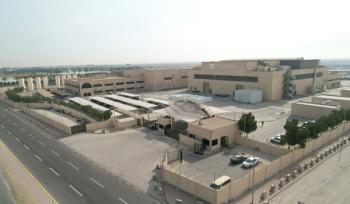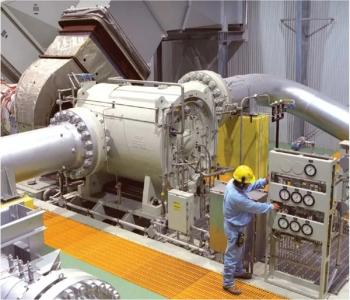
Ivan article series part 4
In this concluding part of the series, the author discusses some of the features of the proposed system that can increase efficiency, and the application of steam super heating and reheating techniques in large industrial units.
One important point that requires mention here is that the proposed split steam cycle will have good part load efficiency, much better than the conventional HD combined cycle.
(An LMS100 aeroderivative gas turbine)
The throttle and reheat temperatures can be kept at their full values for high steam turbine efficiency and output by modulating the supplementary firing to the single superheater. Moreover, the individual GT units can be shut down for improved part load efficiency. Some of the flexible features of the proposed multi-unit cycle that are important to those dealing with power plants are:
Flexibility and costThe proposed system is formatted for mid range and base load operation of each gas turbine with a turn down of maybe 30%. The system, with two units per HRSG, is proposed to save installation cost and would require positive no-leakage dampers so that each gas turbine can be operated separately. The exhaust gas of one unit must not flow back into the other. Maintenance and change out of the gas generators have to be addressed as well. Proper control of the dampers and the steam valves would be required.
Cycling operation of the 5-unit system can be accomplished easily. Four of the 5 units can be shut down at night, for instance, if need be, when the load demand falls off – one unit at a time. The central unit would remain running but reduced to perhaps 50% load (25 MW) so that the central the central LM6000, its HRSG, fired super heater, piping and steam turbine would remain in operation to keep the overall system hot and operable. It would be placed in the spinning reserve mode.
Each of the four shut down gas turbines would be restarted and placed on line in the morning within ten minutes, one at a time, as the load demands pick up. A very flexible and efficient system is thus possible if it is properly engineered. However, when the central gas generator needs to be changed out, the combined cycle part of the plant would have to be shut down. The other four gas turbines could be operated at a respectable 42% efficiency level.
The overall installed cost of the Combo 5 LM 6000 CC and the Combo 3power plants have to be determined and then evaluated against the existing aero 52% efficiency CCs and then the 60% HD CCs. The two outer HRSGs would cost less because of the superheater and reheat elimination, and they would also impose a lower back pressure on the associated gas turbines. The central unit could incorporate an ID fan to reduce gas turbine back pressure, thus saving power (inverted cycle).
Application of other gas turbinesThe same steam super heating and reheating flow split can likewise be applied to the large Rolls-Royce Trent 60 with its 64 MW rating and the just announced Pratt & Whitney PW 4000 with its 60 MW industrial rating. Both of these units with their high compression ratios, high firing temperatures, high specific power output per pound of core air flow, and their resulting high simple cycle efficiencies of 42% make excellent candidates for such combined cycles. This new approach of multiple units with split steam flow for combined cycles and Pratt's new PW 4000 could make GE reconsider industrializing its GE-90 fan engine to offer some 75 MW output at even higher simple cycle and CC efficiency levels because of the 90's higher specific core air flow and higher simple cycle efficiency. The higher the specific power, the lower will be the final HRSG stack loss because of the reduced stack gas flow.
As is evident from the author’s 1995 ASME paper number 95-GT-29 which illustrates how the split stream boiler arrangement operates, the gas turbine exhaust temperature would have to be about 1100 oF for a conventional reheat steam turbine. Supplementary firing the total gas stream degrades the overall CC efficiency potential by producing excess steam flow.
In this ASME example, the steam is heated to about 825oF and likewise reheated to 825oF downstream of the topping super heater. Final heating and reheating to 1000 oF is accomplished by the topping super heater through supplementary firing. The superheated gas exit temperature selected is 900oF in this case to match the gas turbine exhaust temperature. For example, the supplementary firing temperature to the boiler is selected to be 1400 oF, but could be raised to 2500 o F or lowered depending on the different exhaust flows and final cost of the boiler arrangement.
The split stream boiler principles are explained in detail in the author's ASME Journal paper, April 1997, volume 119/385, (ASME paper number 95-GT-29) listed on Amazon.com.
In conclusion, it is believed that the latest aero gas turbine offerings can be used, not only for solar and wind power backup but also for intermittent and base load to provide flexible high efficiency combined cycles, powered by the new abundant supply of low cost shale gas. The author believes that the aero CCs will have an increasing place for power generation not only in the US but also around the world.
Ivan G. Rice was past chairman of the South Texas Section of ASME (1974 - 75), past chairman of the ASME Gas Turbine Division (now IGTI) (1975 - 76). A Life Fellow Member of ASME and Life Member of NSPE/TSPE, he has authored many articles and ASME papers on gas turbines, inter-cooling, reheat, HRSGs, steam cooling and steam injection.
Newsletter
Power your knowledge with the latest in turbine technology, engineering advances, and energy solutions—subscribe to Turbomachinery International today.




